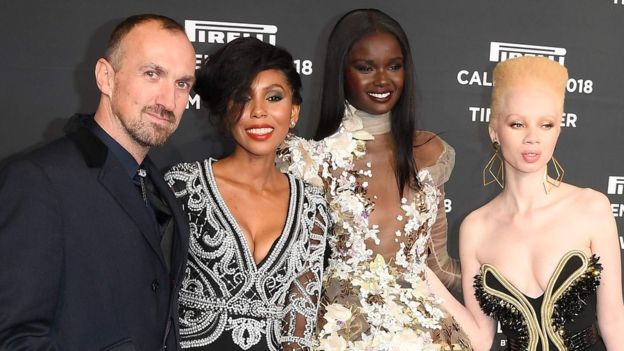
Tim Walker has photographed this year’s models, who include Jaha Dukureh, Duckie Thot and Thando Hopa
Last Christmas, the best-selling calendars for 2017 included Little Mix, Justin Bieber, Kelly Brook and, umm… Cliff Richard.
But it’s fair to say that most of the celebrity calendars you see every year on the supermarket shelves don’t have quite the same status and history as the Pirelli calendar.
The prestigious publication, which has been released annually since 1963 (with an eight-year gap from 1975), is sent out to customers and celebrities of the Italian automotive company every Christmas.
And it’s a pretty big deal.
“The Pirelli calendar would be a dream project for any photographer,” says Caryn Franklin, professor of diversity at Kingston School of Art and former fashion editor at i-D magazine.
“It’s a high-status platform for photographers of note to be given the space to promote their own aesthetic. It’s big budgets and top models.”
But for decades that aesthetic has often meant female stars, albeit artistically photographed, in nude or highly-sexualised positions – an approach which Pirelli has been moving away from in recent years.
“For me, the Pirelli calendar was always something I was conflicted about,” says Leah Sinclair, online editor at The Voice, a newspaper which primarily caters to BAME (black, Asian and minority ethnic) audiences.
“You’d check to see who would be featured in a particular calendar, who the photographer was, what the vision was for it. So it was something you engaged with, but whether you agreed with it was debatable.”
She adds: “For the first 10 years of the calendar, women were fully-clothed, and there wasn’t such an emphasis on their naked bodies, that only came about around the 1980s.
“And that’s when it became more popular and pivotal in people’s lives on a year-to-year basis.”
Photographers to have taken the reins of the Pirelli calendar over the decades have included Karl Lagerfeld, Peter Lindbergh and Robert Freeman, while Sophia Loren, Kate Moss, Gigi Hadid and Karlie Kloss have modelled.
Until as recently as 2015, which had a latex theme (we’d include a link to the images here if they weren’t so post-watershed), the calendar mostly featured eroticised images.
But, as Sinclair points out: “In the last couple of years, there’s been a notable shift in the approach to the calendar. I’d say it’s taken on a more positive tone as they’re now addressing different issues.”
For last year’s publication, some of the world’s top actresses including Dame Helen Mirren, Nicole Kidman and Jessica Chastain were photographed wearing minimal make-up and in black and white, giving the calendar a classy, purer and more natural look.
For 2018’s calendar, which is published this week and styled by Vogue’s new editor Edward Enninful, the theme is Alice in Wonderland.
Tim Walker has photographed this year’s models and the calendar features an all-BAME cast including Naomi Campbell, Whoopi Goldberg and Lupita Nyong’o.
Franklin says: “Here’s a Pirelli calendar where we can see a range of characters, all of whom are black. How often do you see that? For me that’s really exciting.
“It shows we are beginning to tackle entrenched thinking, you know a mostly white perspective, or women who are posturing to the male gaze. That’s old school.”
She continues: “As we move forward now, business begins to recognise that diverse perspectives are valuable, exciting, and they have currency. So the last three Pirelli projects have all shown some recognition of that.”
Sinclair points out: “Even with it being an all-black cast, you’ve got so much variation in there.
“You’ve got people like like RuPaul and Diddy, and also this younger generation of talent like Duckie Thot, who is one of the big rising dark-skinned models.”
Earlier this month, Diddy said: “I think Pirelli was smart enough to see the future. This is the future. Black excellence.
“To see us all together and to be standing tall and proud and to be able to be seen as kings and queens and part of an empire, that’s something I want my little girls to see.”
But taking on the subject of diversity could be seen by some as a cynical move, taking on a topical issue to maximise publicity.
“It’s trendy in a sense – there’s the hashtags like #BlackGirlMagic and #BlackExcellence going around at the moment, there’s a real celebration of black culture right now,” Sinclair says.
“So there’s an element of catching on to something that is popular, but is also embracing of something that’s new.”
The Pirelli calendar has always been about two things – the first is glamour, the second is photography.
It has developed in the recent past, away from nude for nude’s sake, to a more considered editorial theme being explored in a more considered way. It points towards a far more visually literate consumer, who is au fait with the aesthetics of Instagram, selfies, and photography as an everyday language.
But also, the way the photographers are selected to make the calendar and the way in which they’re doing so shows a shift away from the hackneyed, 1970s, page three-type approach, to something which is much more visually sensual and less overtly sexual.
But regardless of whether it’s been done to make a political statement or attract column inches (or both) – Franklin says it’s a welcome move.
“The world is moving on. And the voices of women and people of colour are now changing the game and we reject the previous incarnations of what a woman could look like or what someone of a diverse ethnicity could look like, which would be having a marginalised presence in a calendar like this.”
“The question that makes me ask is whether there’s perhaps a more diverse perspective now amongst the controllers, the people who decide if they will employ an Annie Lebowitz or an Edward Enninful.
“Because, for these people to get through, they have to get commissioned. So what that might imply is that there is no longer a table of middle-aged white men imposing their perspective on the content of the calendar.”
Sinclair agrees: “The calendar is now about addressing different issues. One of the portraits shot by Annie Lebowitz in 2015 was Amy Schumer, who some might say isn’t necessarily your stereotypical idea of beauty, and they had her sitting down naked. And they really pushed forward what the Pirelli calendar is.”
She adds that it’s a sensible move for Pirelli to have shifted the tone of the calendar in recent years.
“The way the Pirelli calendar was done between the 1980s until recently, this objectification of women, isn’t really something that people would accept going forward, so I think it’s just a smart idea for them to evolve,” she says.
“I think they want to draw in a younger audience who are a lot more conscious, you’d be surprised at how much this Generation Z are really engaged in what’s going on. So I think it’s a smart move to address issues like body image, race and female empowerment.”
BBC
 Q FM Africa's Modern Radio
Q FM Africa's Modern Radio